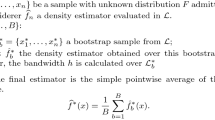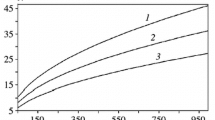Abstract
The number of modes of a density f can be estimated by counting the number of 0-downcrossings of an estimate of the derivative f′, but this often results in an overestimate because random fluctuations of the estimate in the neighbourhood of points where f is nearly constant will induce spurious counts. Instead of counting the number of 0-downcrossings, we count the number of "significant" modes by counting the number of downcrossings of an interval [-∈, ∈]. We obtain consistent estimates and confidence intervals for the number of "significant" modes. By letting ∈ converge slowly to zero, we get consistent estimates of the number of modes. The same approach can be used to estimate the number of critical points of any derivative of a density function, and in particular the number of inflection points.
Similar content being viewed by others
REFERENCES
Cox, D. R. (1966). Notes on the analysis of mixed frequency distributions, British J. Math. Statist. Psych., 19, 39–47.
Cuevas, A. and Gonzalez Manteiga, W. (1991). Data-driven smoothing based on convexity properties, Nonparametric Functional Estimation and Related Topics, NATO Adv. Sci. Inst. Ser. C. Math. Phys. Sci. (ed. C. Roussas), 335, 225–240, Kluwer, The Netherlands.
Donoho, D. L. (1988). One-sided inference about functionals of a density, Ann. Statist., 16, 1390–1420.
Good, I. J. and Gaskins, R. A. (1980). Density estimation and bump-hunting by the penalized likelihood method exemplified by scattering and meteorite data, J. Amer. Statist. Assoc., 75, 42–56.
Hartigan, J. A. and Hartigan, P. M. (1985). The dip test of unimodality, Ann. Statist., 13, 70–84.
Heckman, N. E. (1992). Bump hunting in regression analysis, Statist. Probab. Lett., 14, 141–152.
LeCam, L. and Schwartz, L. (1960). A necessary and sufficient condition for the existence of consistent estimates, Ann. Math. Statist., 31, 140–150.
Lehmann, E. L. (1959). Testing Statistical Hypotheses, Wiley, New York.
Mammen, E., Marron, J. S. and Fisher, N. I. (1992). Some asymptotics for multimodality test based on kernel density estimates, Probab. Theory Related Fields, 91, 115–132.
Shorack, G. R. and Wellner, J. A. (1986). Empirical Processes with Application to Statistics, Wiley, New York.
Silverman, B. W. (1980). Comments on Good and Gaskins, J. Amer. Statist. Assoc., 75, 67–68.
Silverman, B. W. (1981). Using kernel density estimates to investigate multimodality, J. Roy. Statist. Soc. Ser. B, 43, 97–99.
Silverman, B. W. (1983). Some properties of a test for multimodality based on kernel density estimates, Probability, Statistics and Analysis (eds. J. F. C. Kingman and G. E. H. Reuter), 248–259, Cambridge University Press, Cambridge.
Silverman, B. W. (1986). Density Estimation for Statistics and Data Analysis, Wiley, New York.
Singh, R. S. (1979). On necessary and sufficient conditions for uniform strong consistency of estimators of a density and its derivatives, J. Multivariate Anal., 9, 157–164.
Wong, M. A. (1982). A hybrid clustering method for identifying high-density clusters, J. Amer. Statist. Assoc., 77, 841–847.
Wong, M. A. and Lane, T. (1983). A k-th nearest neighbour clustering procedure, J. Roy. Statist. Soc. Ser. B., 45, 362–368.
Author information
Authors and Affiliations
About this article
Cite this article
Fraiman, R., Meloche, J. Counting Bumps. Annals of the Institute of Statistical Mathematics 51, 541–569 (1999). https://doi.org/10.1023/A:1003958323950
Issue Date:
DOI: https://doi.org/10.1023/A:1003958323950




